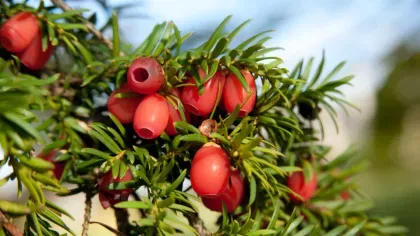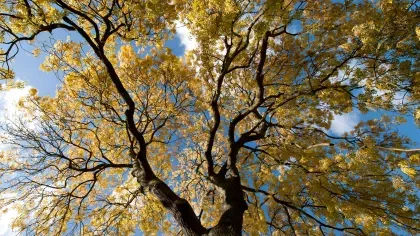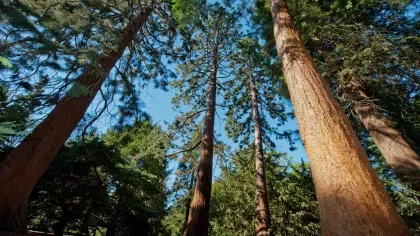
Common oak
On this page
Probably one of the most recognisable trees in Britain, the common oak (Quercus robur) is a cultural icon.
Oak trees, leaves and acorns all feature on coats of arms, company logos and coins.
Growing tall and broad, the common oak can be found in woodlands across Europe and plays a key role in forest ecosystems.
Oak is also incredibly popular as a provider of lumber, being a strong and resilient hardwood used in flooring, furniture and barrel making.
The Bowthorpe oak, a common oak found in Bourne, Lincolnshire is thought to be the oldest in the United Kingdom at over 1,000 years old.
Plant description
Common oak trees can grow over 20 metres tall, and over 8 metres wide. The trunks tend to be wide, with thick, rough and grooved dark brown bark.
The leaves are dark green on the upper side and pale green on the lower, and have between 3 to 6 lobes. The stalk attaching them to the branches is particularly short. Flowers are either thin, cylindrical clusters (catkins) or small brown flowers.
The fruits, known as acorns, grow on long stalks from the branches in clusters of two or three. Acorns are around 3cm long, can be green or brown depending on maturity, and grow in a small cup on the stalk.




Plant uses
Cultural
In Druidic belief, oak trees play a key role in rituals, and are a source of mistletoe which often grows in oak canopies.
A number of ancient lightning gods, including the Dagda in Irish mythology, Zeus in Greek mythology and Thor in Norse mythology are associated with oak trees, due to their frequency of being struck by lightning bolts.
The major oak in Nottinghamshire is supposedly the tree round which Robin Hood and his Merry Men gathered.
Oak leaves are the logo for many UK-based nature organisations, including the Woodland Trust and the National Trust.
Food and drink
Acorns, although largely considered a famine food, have been eaten throughout history.
Ground acorns can be used to make flour for breads, or in the preparation of acorn coffee.
Oak wood chips are used for smoking foods like meat and cheeses.
Materials and fuels
Oak wood is highly prized for its strength and hardness, and has been used to make buildings, ships, floors and furniture throughout history.
French wine is often aged in barrels made from common oak wood.
Did you know?
Common oaks often play host to numerous gall wasp species that create oak galls by laying their eggs in the buds of acorns.
The genus name Quercus is a Latin word that means 'oak', while the species name robur means both ‘hard wood’ and ‘oak’.
The common oak has been hybridised with a number of other oak species, including the holly oak (Quercus ilex) to produce Turner’s Oak (Quercus x turneri), one of which still grows at Kew Gardens today.
Kew Gardens is home to over 1000 common oak trees, found all across the Garden.
Most acorns that grow into young oaks are distributed by Eurasian jays (Garrulus glandarius), as squirrels leave the fruits too damaged to sprout.
Where in the world?

Woodlands and forests across Europe and beyond, in a variety of soil types.
Find it in our gardens
Kew Gardens
A botanic garden in southwest London with the world’s most diverse living plant collection.
Location
View map of Kew GardensBest time to see
Wakehurst
Kew’s wild botanic garden in Sussex that has over 500 acres of plants from around the world and is home to the Millennium Seed Bank.
Location
Near the Visitors Centre, and across Wakehurst
View map of WakehurstBest time to see
Our work
Acute oak decline is a disease affecting common oaks and sessile oaks (Quercus petraea) across the UK that can kill trees within just a few years.
The disease mostly affects older trees, and includes symptoms such as bleeding dark fluid from the trunk and sudden thinning of the crown of the tree.
Unfortunately, we don’t currently understand the exact cause of acute oak decline. But we want to understand more about why certain trees are at higher risk.
Kew is using large-scale genome sequencing to learn more about the health of Britain’s oak trees which are threatened by not only acute oak decline, but also mildews and other fungal infections.
We’re aiming to sequence the DNA of over 2000 oak trees from across Britain, looking at the genetic variation alongside health traits and environments. We also want to discover if there is a genetic component to acute oak decline.
In the future, this research will help tree planters choose the right acorns for the right sites.
Learn more about the genomics of British oak trees project









